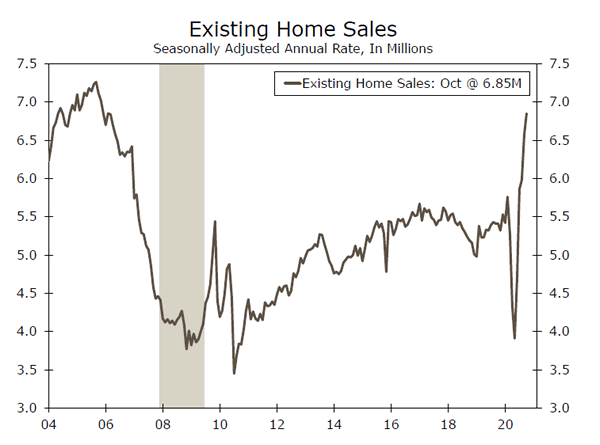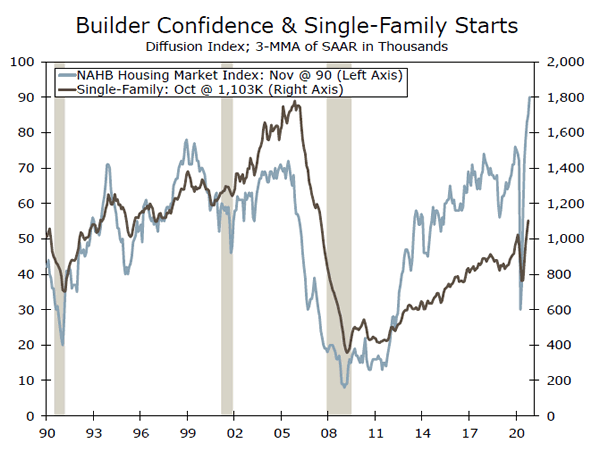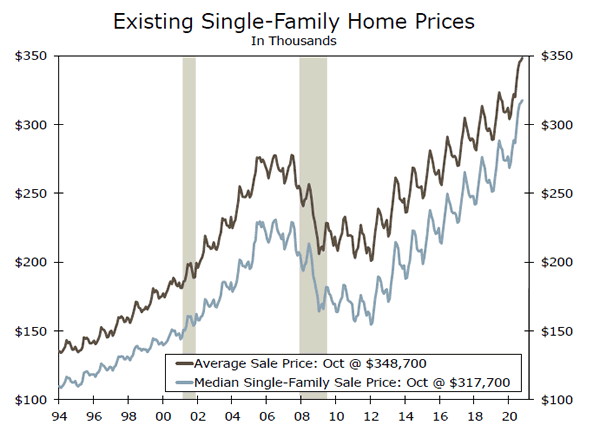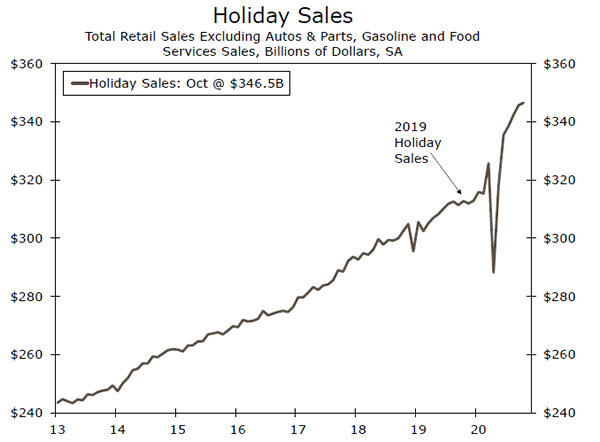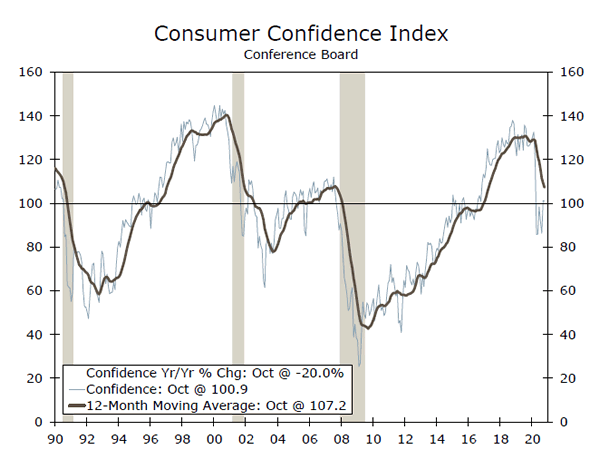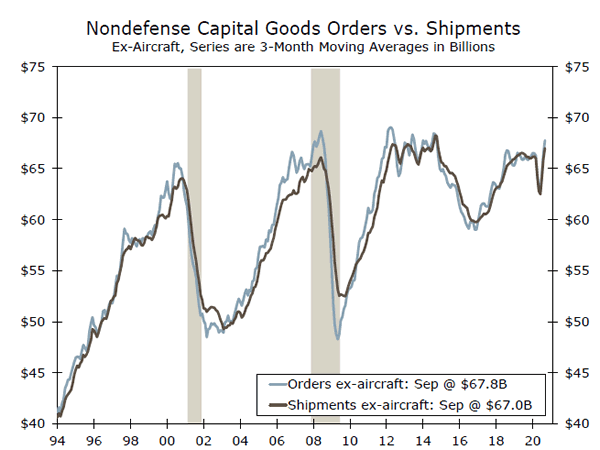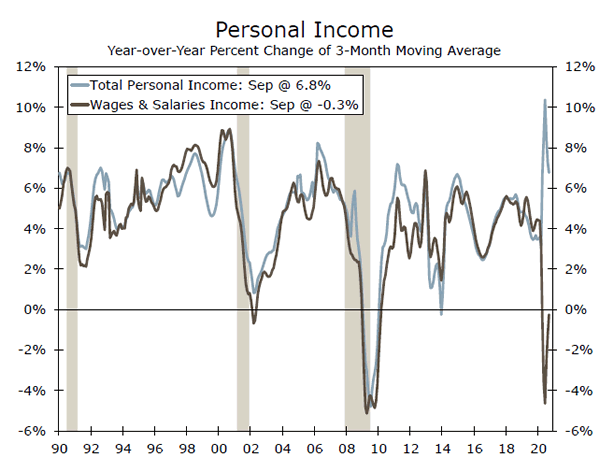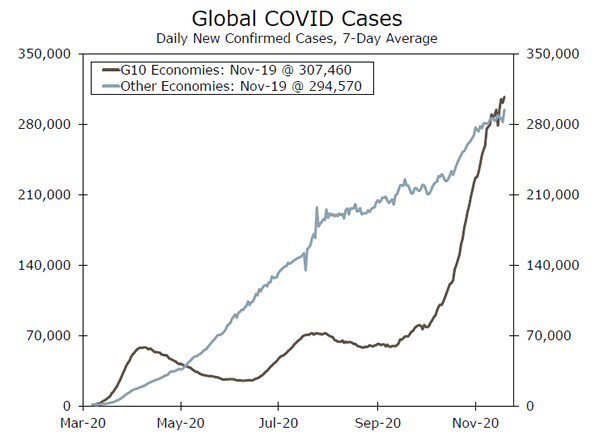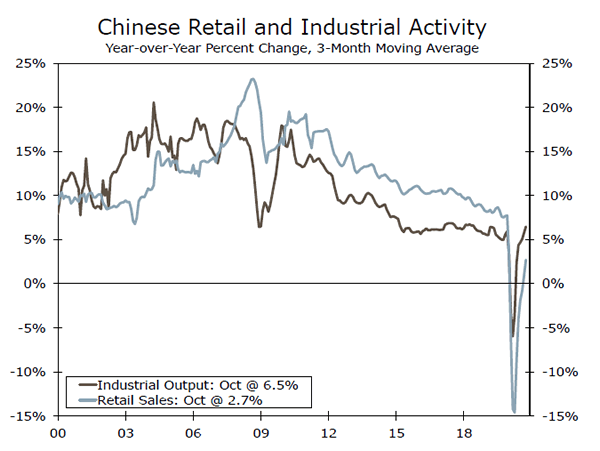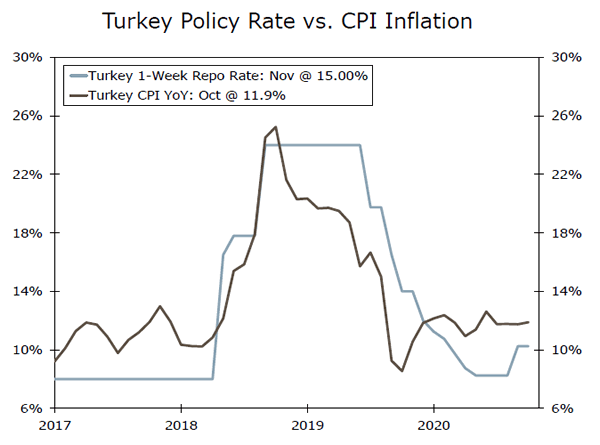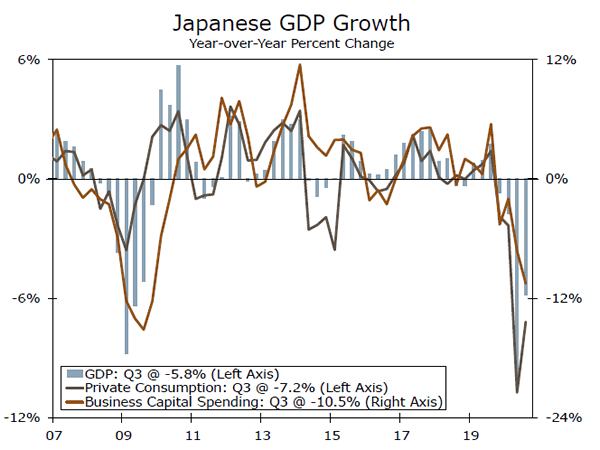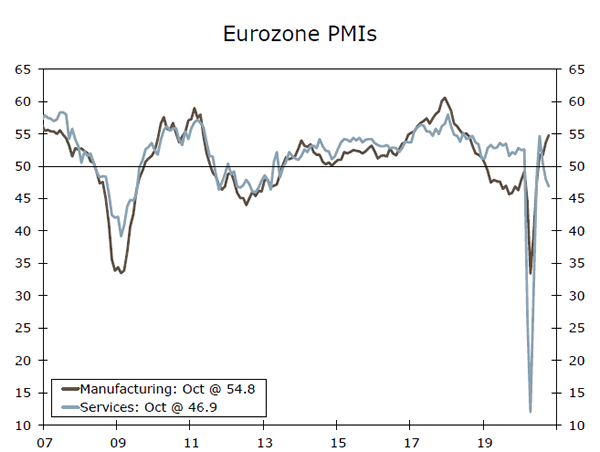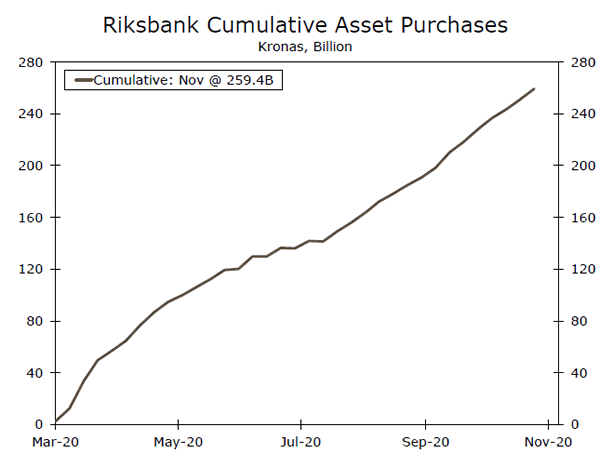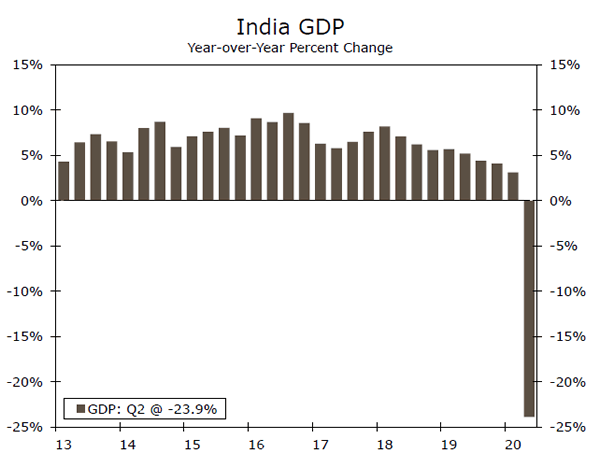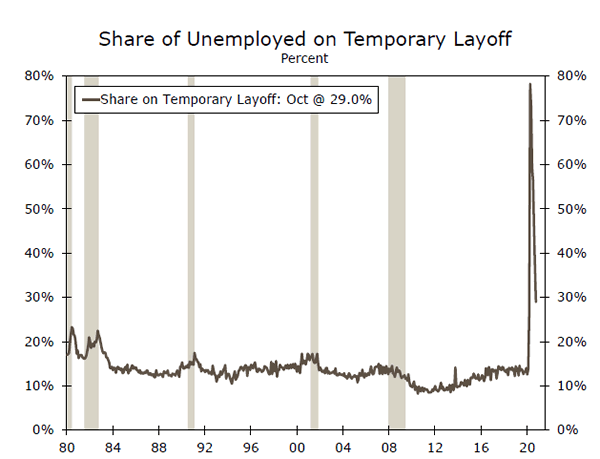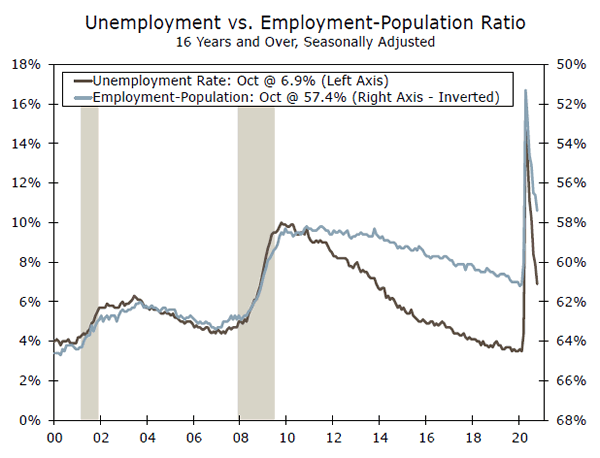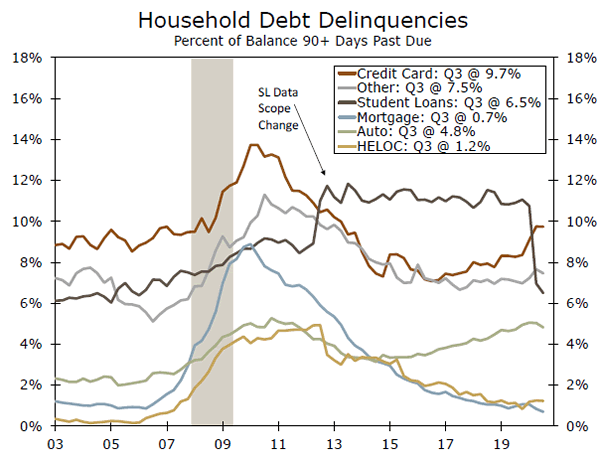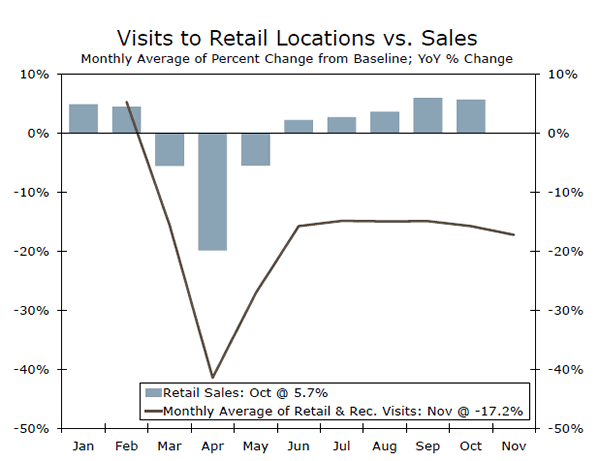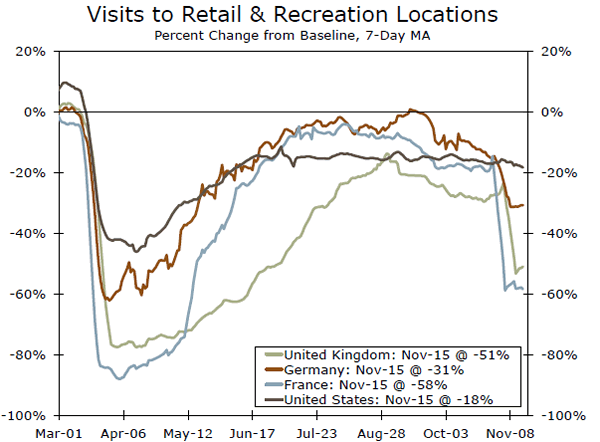U.S. Review
House Party
- Soaring confidence among homebuilders, a pace of residential construction activity that topped expectations and existing homes selling at the fastest pace in 14 years were the highlights of a week in which housing data dominated the economic news.
- The consumer rebound has been another strong part of the economic recovery, although retail sales figures released this week showed that spending was losing momentum in October, even as holiday sales remain on track for a banner year.
The Starts of Something Big
Housing starts again bested expectations climbing 4.9% in October, on the heels of upward revisions to the prior month. Rather than new multifamily projects which have been just treading water the past few months, single-family starts accounted for all of October’s increase, with starts rising 6.4% to a 1.179-million-unit pace in October. This marks the sixth consecutive increase for single-family starts, which are now at their highest level since April 2007.
The jump in single-family starts shows no sign of abating as the latest reading of the National Association of Homebuilders’ index rose to yet another record high in November, the third straight monthly record. Builder optimism is being bolstered by exceptionally strong sales coupled with extraordinarily low inventories.
Historically, a construction boom could only do so much to lift economic activity heading into the colder winter months, but that may be less of a limiting factor in this cycle. Just over 80% of all single-family homes built over the past year have been in the South or West where milder winter weather may allow activity to progress with fewer stoppages.
The action in the housing market is not limited to construction activity, however. The surge in existing home sales continued in October, jumping 4.3% to a 6.85-million-unit pace in October. The pandemic has sparked a demand for existing homes that has not been seen since the height of the housing euphoria in 2006. Although, two factors will make it difficult for this sharp upward pace to be maintained. The first is we are running out of homes to buy. Inventories of existing homes dropped to 1.42 million, 19.8% below year-ago levels. At the current pace of sales, that leaves only a two and a half month supply, the lowest on record. The other limiting factor is prices. With median home prices now north of $300K and average prices knocking on the door of $350K, the price mechanism will eventually slow the torrid ascent in home prices.
Not According to Santa’s Watch, It Isn’t
It may appear that the surge in consumer spending is over. Retail sales increased only 0.3% in October, which was below the 0.5% expected by the consensus, and making things worse is the fact that September’s 1.9% increase was dialed back to an increase of just 1.6% after revisions.
Despite the lousy outturn in October, our grouping of store types that comprise overall holiday sales is actually higher than what we had been forecasting for October in our Holiday Sales report. This is largely attributable to revisions to prior months.
In terms of holiday sales underlying categories, e-commerce (Prime Day was in October this year), as well as electronics and building materials all came in much better than we had expected, which offset the larger declines in other categories.
Holiday sales are already 10.8% above where they stood last December. Even if we are down slightly in the final months of the year, we are still on track for a banner year for holiday sales, on a year-over-year basis.
U.S. Outlook
Consumer Confidence • Tuesday
The Conference Board’s consumer confidence index has held right around the 100 level over the past two months. While this is down roughly 20% over the year, in the grand scheme of what has transpired in 2020 this is still a fairly robust reading. Consider that the consumer confidence index averaged 98 over the course of 2015, which saw the first rate hike of the cycle in the final month of that year. Perhaps even more interesting, the future expectations component has held up even better; at 98.4 in October, this reading was about 4% higher than it was a year ago.
Whether such optimism will carry into the winter months, however, remains an open question. State and local governments began to pause or rollback reopening plans more severely over the past few weeks, and the economic fallout may occur with a lag. The next several of consumer confidence readings will offer a look into how the spike in cases has affected consumers’ confidence levels.
Previous: 100.9 Wells Fargo: 99.3 Consensus: 98.0
Durable Goods Orders • Wednesday
Nondefense capital goods orders and shipments have been on the rise over the past few months, increasing 1.0% and 0.5%, respectively, in October. Like the consumer confidence index, it is impressive that core capital goods orders have held up as well as they have: Compare the 2020 declines with the one that occurred from 2014-2016 or the declines during the previous two recessions (chart to the left). Investment plans are on the upswing and there may arguably be some pent-up demand for capex since equipment spending peaked a full year before the pandemic.
With a vaccine appearing to be not too far off, it looks increasingly like the economy just needs to get through another six months or so before the worst of COVID is behind us. But with COVID cases and deaths accelerating and additional fiscal stimulus still elusive, the medium- to long-term optimism must be weighed against the potential economic damage that might be wrought in the near term.
Previous: 1.9% Wells Fargo: 0.5% Consensus: 1.0%
Personal Income & Spending • Thursday
Real personal spending has been clawing its way back to pre-pandemic levels and was only 2% below year-ago levels in September. We believe the recovery continued in October and look for real personal spending to grow 0.2% in the month.
Given the economic destruction brought on by COVID, how have all of these economic indicators held up so well? In large part, the resiliency of the U.S. economy can be attributed to the enormous monetary and fiscal policy support that has been delivered in 2020. Even as some forms of income support have faded, such as the direct payments to households and the extra $600 per week in unemployment benefits, personal income was still up nearly 7% on a year-over-year basis in September. This support has bought time for private sector sources of income, such as wages and salaries, to steadily recover. Whether the labor market can hang in through the tough winter months remains the key question to the near term outlook.
Previous: 1.4% Wells Fargo: 0.2% Consensus: 0.5% (Month-over-Month, Personal Spending)
Global Review
Uneven and Uncertain Global Economic Recovery
- The international economic news over the past week has been somewhat mixed. On the positive side, China’s October data showed ongoing growth in manufacturing and firming retail and service sector activity. While Chinese growth is supporting the Asian region, last week did see central banks in Indonesia and the Philippines ease monetary policy further.
- The global growth outlook, especially over the interim period ahead, remains uncertain given the renewed spread of COVID cases among developed economies in particular. Growth is slowing across Europe, and next week’s Eurozone November PMIs could perhaps signal negative GDP growth in Q4.
China Continues to Lead the Global Recovery
The latest batch of economic data from China suggest that country’s economic rebound has continued largely uninterrupted, with China still clearly leading the global recovery. For now the manufacturing sector remains the center of the rebound, as October industrial output rose 6.9% year-over-year, the same increase as in September and slightly above the consensus forecast. However other areas of the economy that had been lagging are now starting to catch up. October retail sales firmed to 4.3% year-overyear, while a broader measure of service sector production also rose 7.4% in October.
With Chinese authorities successful in containing the spread of COVID over the past several months, we believe China’s recovery can continue at a solid pace. In fact, China is the only key global economy for which we expect positive GDP growth for 2020, rising 2.2%, while in 2021, we expect China’s GDP to surge 9.5%.
Plenty of Action from Emerging Market Central Banks
Several emerging market central banks adjusted their monetary policy stance over the past week. Of particular note, Turkey’s central bank hiked its one-week repo rate 475 bps to 15.00%, matching market expectations. The move comes after a period of significant financial market volatility, even by Turkey’s standards. This week’s policy action is the first under new central bank governor Naci Agbal, after the previous central bank governor was replaced by Turkish president Erdogan. Although the Turkish lira has benefited from interest rate actions that are perceived as more orthodox, the economic outlook for Turkey remains challenging. As a result, we still expect the lira to soften against the U.S. dollar over the medium term. In Asia, there was some activity but far less excitement from some of the region’s central banks. Indonesia’s central bank unexpectedly cut its seven-day reverse repo rate by 25 bps to a record low 3.75%, in the context of relatively subdued economic trends and with the central bank governor encouraging banks and businesses to build optimism. In the Philippines, the central bank also unexpectedly cut its overnight borrowing rate by 25 bps to 2.00%. Given some headwinds to the economy, including the spread of COVID and recent typhoon activity, the central bank governor said he is ready to use all available tools.
Japan’s Economy Recovery Under Way in Q3
Japan’s economy experienced a steady rather than spectacular rebound during the third quarter. Q3 GDP rose 5.0% quarter-overquarter (not annualized), a bit more than the consensus forecast but still not recovering the 8.2% decline in Q2. Consumer spending was solid, rising 4.7% quarter-over-quarter, while exports jumped 7.0%. However, business capital spending was a soft spot, falling by 3.4% quarter-over-quarter. With COVID cases less widespread in Japan than in some Western economies, we believe economic growth can be sustained in the quarters ahead. As a result in the current very unusual global environment, we have a “middle of the road” forecast for Japan’s economy, expecting GDP to fall by 5.8% in 2020 and grow by 2.4% in 2021.
Global Outlook
Eurozone PMIs • Monday
With the resurgence in COVID cases across the Eurozone and the renewed imposition of restrictions by several governments, widespread concerns of a renewed decline in the Eurozone economy have emerged. The purchasing managers indices are among the mostly timely economic readings, and next week’s release of November figures will likely be consistent with Q4 contractions. The service sector in particular should soften further, with the services PMI seen falling t0 42.0, from 46.9 in October. The manufacturing PMI is also expected to drop, but to 53.2 which would still be above the breakeven 50 level.
Other important November confidence surveys are also due next week. Germany IFO business is expected to fall t0 90.3, with the assessment of current conditions as well as the expectation component both expected to decline. Meanwhile Eurozone economic sentiment is also forecast to decline, to 86.5.
Previous: 54.8 & 46.9 Consensus: 53.2 & 42.0 (Manufacturing & Services)
Riksbank Policy Announcement • Thursday
The Riksbank announces its monetary policy decision next week. We expect monetary policy to remain on hold, and see the central bank keeping its repo rate at 0.00%, as well as to continue its bond purchases within the current purchase program.
While the Riksbank has maintained a mild easing bias, we believe policy action is unlikely next week and indeed over our forecast horizon. The economy has shown modest improvement, with Q3 GDP expected to rise 4.3% quarter-over-quarter. October confidence surveys firmed, and September private sector production edged higher. Thus, even with inflation running only modestly above zero and a rise in COVID cases of some concern, we see no urgency for the central bank to act at this time. Next week also sees a couple of notable data releases. October retail sales are forecast to edge up 0.1% month-over-month, while November economic confidence is also released.
Previous: 0.00% Wells Fargo: 0.00% Consensus: 0.00%
India GDP • Friday
An update for one of the more significant emerging economies occurs next week, when India reports GDP figures for Q3. The economy slumped in Q2, falling 23.9% year-over-year, which roughly equated to a sequential decline of 25% quarter-over-quarter (not annualized).
Like many other countries, India’s economy likely rebounded significantly, but not fully in Q3. Industrial output rose 0.2% yearover- year in September, the first positive reading since February, while the manufacturing and services PMIs both improved further in October. Given these encouraging signals, the annual decline in Q3 GDP is expected to be much smaller than in Q2, with the consensus looking for a fall of 8.5% year-over-year. While the improvement in Q3 will be welcome, the longer-term outlook for India’s economy remains challenging, given a buildup of non-performing loans, the spread of COVID-19 still quite prevalent, and with fiscal stimulus reasonably limited to date.
Previous: -23.9% Consensus: -8.5% (Year-over-Year)
Point of View
Interest Rate Watch
Can Early Signs of Less Scarring Last?
Echoing the recovery from the financial crisis, the unemployment rate has fallen faster than Fed officials have expected. Back in June, the median estimate among FOMC members projected the unemployment rate at 9.3% for Q4, but as of the first month of the quarter, it had already fallen to 6.9%.
The rapid descent in the unemployment rate has, in part, stemmed from the unusually high share of unemployed workers on temporary layoff, even eight months into the pandemic (top chart). Temporary layoffs keep workers connected to employers, cutting down on the time and cost of re-staffing/returning to a job. Research from the San Francisco Fed shows that currently temporary layoffs are not becoming permanent at a higher rate than prior periods. While the COVID crisis is not yet over, that suggests the potential for labor market scarring to be more limited than in the wake of the Great Recession.
The swift drop in unemployment and possibility for relatively quick recovery won’t give the Fed an itchy trigger finger when it comes to scaling back accommodation, however. For one, under the Fed’s new framework, the FOMC has pledged to focus on shortfalls in employment, rather than deviations. In other words, the bar for raising rates rests on inflation reaching 2% on average.
In addition, there remains a substantial amount of slack on the sidelines. Despite a steady decline in the unemployment rate, the labor force participation rate has more or less moved sideways since June. Accounting for the reduction in the labor force, the employment-population ratio shows less improvement than the unemployment rate (middle chart).
Moreover, recent efforts to curtail the latest wave of COVID cases threaten the labor market’s progress. Thursday’s jobless claims report showed filings rising for the first time in five weeks. Renewed weakening in the labor market as the crisis continues raises the risk of more layoffs becoming permanent. Therefore, it is still too early to assume less labor market scarring, which is one more reason the Fed has no plans to ease up on accommodation anytime soon.
Credit Market Insights
Credit Where Credit’s Due
On Tuesday, the Federal Reserve Bank of New York released its Quarterly Report on Household Debt and Credit, providing a glimpse into household balance sheets as we head into the winter. In the third quarter, household debt balances increased $87 billion after falling $34 billion in Q2. The retrenchment in credit card debt, which drove last quarter’s decline, continued as consumers paying down outstanding debt outweighed increased spending. In contrast, mortgage and auto debt rose, with both categories seeing a surge of new loans. Auto loan originations hit a record high, with $168 billion in new loans or leases appearing on consumer’s credit reports. Mortgage originations, which include refinancing, jumped to their highest level since 2003, as the housing market boomed and homeowners took advantage of record low mortgage rates. While this surge in credit extensions does seem at odds with reports of tightening credit standards, the median credit score at origination rose for auto and home loans.
Delinquency rates continued to fall in the third quarter. While some of this is due to consumers using stimulus and excess savings to pay down their debts, these rates are also being flattered by a range of forbearance programs. Most forbearance provided by the CARES Act or offered by lenders prevents skipped or deferred payments from being marked delinquent on credit reports, which make up the underlying data for the New York Fed’s report.
Topic of the Week
Will COVID Crush Retail Spending Again?
As is widely known, the number of new COVID cases has reached record numbers recently. Over the past seven days, the number of new cases in the United States has averaged roughly 165K per day, up from less than 100K at the end of October. In response, many state and local government officials have been tightening restrictions again. For example, Governor Brown of Oregon ordered a two-week “freeze” that forces gyms as well as indoor and recreational facilities to close, and she limited restaurant sales to take-out and delivery only. In New Mexico, Governor Grisham ordered the closing of inperson services for all non-essential activities for two weeks. Renewed restrictions are being imposed to varying degrees in other states as well. What effect will these renewed restrictions have on the economy?
We follow daily mobility data that are provided by Google to give us real-time insights into consumer activity. As shown in the top chart, visits to retail and recreational establishments tanked in March and April when the country went more or less into lockdown mode. This nosedive in the number of visits to retail establishments by consumers was associated with the 20% year-overyear drop in retail sales in April. But as the economy started to re-open in late April and May, retail visits rebounded and retail spending accelerated sharply. We will be keeping a close eye on the mobility data in coming days and weeks, but the recent swoon in retail visits in many European countries (bottom chart), which have reimposed restrictions in recent weeks, is not encouraging.
That said, consumer spending may not be as negatively affected as it was earlier this year. The measures announced so far do not appear to be as restrictive as they were in the spring, they generally are expected to remain in place for only two weeks, and not all states have adopted them. Furthermore, consumers have become adept at online shopping. In that regard, sales at “nonstore” retailers were up 29% (year-over-year) in October. That said, consumer spending could weaken in coming weeks if COVID cases continue to spike. Stay tuned.




